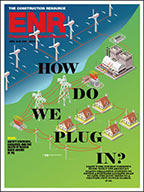First Subsea, based in the U.K., has supplied an innovative cable-connector system in preparation for linking to the first of two 7-MW floating wind turbines for the second phase of the Fukushima offshore floating pilot wind test project this summer.
After a magnitude-9.0 earthquake on March 11, 2011, triggered a tsunami and knocked a nuclear powerplant off line, the Japanese government was quick to seek alternative means of generating electricity.
The test project, commissioned in 2012 by the Japan Ministry of Trade, Economy and Industry, is laying the foundation to build the largest offshore wind farm in the world, with 143 turbines generating 1 GW of energy. The project has received support since the 2011 earthquake and tsunami, though many argue renewables alone cannot replace power produced by nuclear powerplants.
Installation of the first of two 7-MW Mitsubishi Heavy Industries turbines originally was scheduled in February at Onahama Bay but is now planned for an unspecified date this summer, according to a spokesman for Marubeni Corp., Tokyo, project integrator for the University of Tokyo offshore-wind consortium.
The First Subsea cable connector allows for quicker installation of prestripped cable through a J-tubeless, instantaneous structural connection to the monopile’s internal hang-off deck, says Greg Campbell-Smith, business development manager at First Subsea in Lancaster, Lancashire, England.
The ball and taper is pulled through the connector and bend stiffener to connect to the turbine or substation, he says. “Making the connection automatic between the bend-stiffener connector and the hull saves time offshore. The mechanism is designed specifically for the polymer bend stiffener that absorbs the motion of the floating offshore-wind structure to protect the cable at the point of entry [to the turbine or substation],” he says.
The system is expected to help cut costs because it does not require a diver or remotely operated vehicle for the installation of the floating turbines. The cost of deploying an offshore vessel to assist with installation can range from 4,000 to 8,000 British pounds, or U.S. $6,140 to $13,300, Campbell-Smith says. In the U.S., costs are estimated at $100,000 a day but are decreasing, due to the oil-price downturn.
Installation of offshore-wind platforms, using two to four divers working around the clock, is also expensive. “If you can make the connection quicker using an automatic latching system, you are saving a considerable amount of time,” Campbell-Smith says.
“By the industry’s own estimates, pre-termination of power cables will cut installation times by 36 hours per cable, with an equivalent cost saving of just under 100,000 euros [U.S. $112,000] per cable,” says a spokesman for First Subsea. Pre-stripped cables will contribute significantly to this figure by reducing to just a few hours the time needed to install the cable.
The First Subsea hang-off connector is pre-installed onto the cable while onshore, and the cable is pre-stripped under factory-controlled conditions, rather than offshore on the monopole, the spokesman says. “In addition, the cores are cut to length, ready to connect into the distribution board, effectively taking this element of cable preparation off the offshore critical path.”





